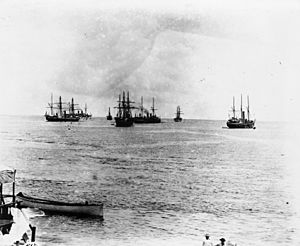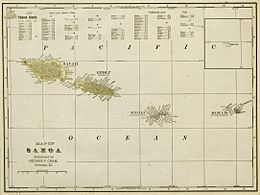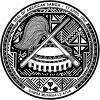Tripartite Convention facts for kids
Quick facts for kids Convention between the United States, the German Empire, and Great Britain Governments in Respect to Samoa |
|
|---|---|

German, British, and American warships in Apia harbour, 1899
|
|
| Signed | 2 December 1899 |
| Location | Washington |
| Effective | 16 February 1900 |
| Signatories | |
| Citations | 31 Stat. 1878; TS 314; 1 Bevans 276 |
| Abrogated the Treaty of Friendship and Commerce Between the United States and the Government of the Samoan Islands of 17 February 1878 (20 Stat. 704; TS 312; 1 Bevans 437). Abrogated the Treaty of Berlin of 14 June 1889 (26 Stat. 1497; TS 313; 1 Bevans 116). | |
The Tripartite Convention of 1899 was an important agreement. It ended the Second Samoan Civil War. This agreement divided the Samoan archipelago into two parts. One part became a German colony, and the other became a United States territory.
Before this convention, there were other meetings and agreements. These included the Washington Conference of 1887, the Treaty of Berlin of 1889, and the Anglo-German Agreement on Samoa of 1899.
Contents
Why Samoa Was Divided: A Look at Past Politics
By the 1870s, Samoa was changing. Modern ways of doing business were becoming common. Samoa had a government, but foreign businesses often tried to control it.
After the United States made a friendship treaty with Samoa in 1878, Germany made its own treaty in 1879. Great Britain also signed a treaty with a different group in Samoa that same year. These different agreements caused problems. Foreigners in Samoa disagreed, and local groups also fought. Modern weapons made these fights very dangerous.
Early Attempts to Solve Problems: The 1887 Washington Conference
To try and fix these issues, the United States, Germany, and the United Kingdom met in Washington in June 1887. But they could not agree on anything important. The meeting ended without solving the problems.
Fighting continued among the people from the three powers and their local allies. This conflict almost led to a major war. However, a huge storm, the Apia hurricane of 1889, hit and wrecked many warships. This natural disaster stopped the fighting for a while.
The leaders realized how serious the situation was. Germany's foreign minister, Count Herbert von Bismarck, suggested another meeting. He invited representatives from the U.S. and Britain to Berlin in April 1889.
Bismarck wanted to protect the lives, property, and businesses of the treaty countries. He thought the Samoans should handle their own government and "kings." The British agreed with this idea.
However, the United States wanted the three powers to share authority. They also wanted to protect the rights of the Samoan people. The Treaty of Berlin of 1889 created a "joint protectorate" or shared rule. This meant a European or American judge would be in charge, and there would be a council for Apia. The treaty also said Samoans had the right to choose their own chief or king.
But this shared rule did not work well. Soon after a Samoan king was chosen, other chiefs rebelled. This led to the Second Samoan Civil War. By the late 1800s, everyone agreed the plan had failed. The main countries involved often ignored the rules of the shared government.
The Tripartite Convention of 1899: Dividing Samoa

The German government always believed that international control of Samoa would not work. They started to make diplomatic moves to end it completely. In April, the British government agreed to form a joint commission with Germany and the U.S. to discuss the matter.
This Joint Commission on Samoa had the power to take over from local authorities and settle things. When they arrived in May, the fighting stopped. By July, the commission decided that the islands had to be divided. They realized that sharing rule was impossible.
The American commissioner, Bartlett Tripp, agreed with President McKinley. They believed the United States should keep Tutuila and its harbor of Pago Pago. Since dividing Samoa was the main idea, the U.S. did not object to Britain and Germany making a preliminary agreement.
Britain was busy with the Second Boer War at the time. This made them seem to be in a weaker position for bargaining. However, Germany wanted to finish the talks quickly and add the western Samoan islands to their empire. This desire helped balance the agreement that was signed.
Kaiser Wilhelm II of Germany was going to visit England in November 1899. His government insisted that an agreement on Samoa should be made before he left. A settlement was reached in London by November 9 and signed on November 14. This Anglo-German agreement, along with an informal understanding with the U.S., was what divided Samoa.
The three powers then needed to make a formal agreement. This was the Tripartite Convention of 1899. The documents were signed in Washington on December 2, 1899. The signers were U.S. Secretary of State John Hay, German ambassador Baron Theodor von Holleben, and British ambassador Sir Julian Pauncefote. The agreement officially took effect on February 16, 1900.
What Each Country Gained from the Convention
United States:
President William McKinley signed an order on February 19, 1900. It said that the island of Tutuila and all other islands east of 171 degrees west longitude would be controlled by the U.S. Navy. These islands would become a naval station.
On the same day, John Davis Long, the Secretary of the Navy, said these islands would be called the "naval station, Tutuila." They would be under the command of a commandant. Rose Island and the island of Aunu'u were included.
The islands of the Manua Group (Ta'u and Ofu-Olosega) were officially given to the U.S. in 1904. However, their chiefs had already accepted U.S. rule. The name "American Samoa" became common in 1905. This was when the first assembly, or fono, of Samoan chiefs from all the ceded islands met.
German Empire: The Samoan islands of Upolu and Savaii, along with the smaller islands of Apolima and Manono, were declared a protectorate of the German Empire. These islands became known as German Samoa. The German flag was raised on March 1, 1900, and Wilhelm Solf was appointed governor. Germany saw this as a great success for their colonial policy.
United Kingdom: By giving up all its rights in Samoa, the United Kingdom received many benefits from Germany in other places. These included:
- All German rights in the Tonga group, including the right to set up a naval and coaling station.
- A change in the border between German and British islands in the Solomon group. This gave Britain all German islands to the east and southeast of Bougainville.
- The division of a "neutral zone" in West Africa with a clear border between British and German lands.
- Germany's promise to consider Britain's wishes about trade tariffs in Togo and the Gold Coast.
- Germany giving up its special rights in Zanzibar.
These agreements from the Tripartite Convention of 1899 remained in place until World War I began in 1914.
See also
 In Spanish: Convención Tripartita para niños
In Spanish: Convención Tripartita para niños
- Treaty of Cession of Tutuila
- Treaty of Cession of Manu'a
- Samoan unification


